Implant with a base body of a biocorrodible magnesium alloy
- Summary
- Abstract
- Description
- Claims
- Application Information
AI Technical Summary
Benefits of technology
Problems solved by technology
Method used
Image
Examples
Embodiment Construction
[0046]To characterize the inventive alloy system, numerous compositions were melted, cast and extruded, and their microstructure, thermomechanical properties, corrosion behavior and physiological effects were determined with the help of different test methods.
General Procedure for Production of Alloy
[0047]High-purity starting materials (≧99.99%) were melted in steel crucibles under a protective gas (CO2 / 2% SF6). The temperature was raised to 760° C. to 800° C. before the melt was homogenized by stirring. The melt was cast to form bars with a diameter of 120 mm and a length of 300 mm. Next the bars were machined to a nominal diameter of 75 mm with a length of 150 mm to 250 mm and tempered for 4-8 hours at approximately 525° C.
[0048]The material was then extruded with the help of a hydraulic press and the resulting round rods had a diameter of 3.2 mm to 25 mm, mostly 9.5 mm. For the following investigations, end pieces 30 cm long were usually removed.
[0049]Table 1 summarizes the compo...
PUM
| Property | Measurement | Unit |
|---|---|---|
| Fraction | aaaaa | aaaaa |
| Fraction | aaaaa | aaaaa |
| Fraction | aaaaa | aaaaa |
Abstract
Description
Claims
Application Information
 Login to View More
Login to View More - R&D
- Intellectual Property
- Life Sciences
- Materials
- Tech Scout
- Unparalleled Data Quality
- Higher Quality Content
- 60% Fewer Hallucinations
Browse by: Latest US Patents, China's latest patents, Technical Efficacy Thesaurus, Application Domain, Technology Topic, Popular Technical Reports.
© 2025 PatSnap. All rights reserved.Legal|Privacy policy|Modern Slavery Act Transparency Statement|Sitemap|About US| Contact US: help@patsnap.com



